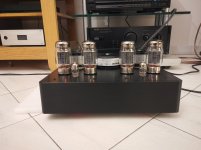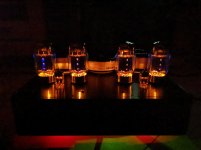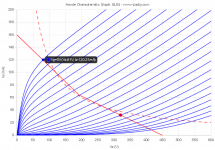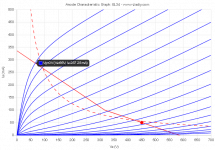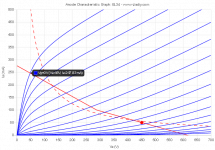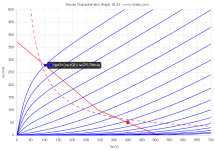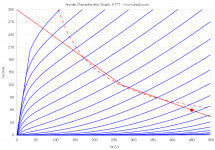I am shocked by this sad news! We will all miss Marc and his great contributions to this forum and our hobby! My condolences too out to his family and friends. This has been such a bad year for everyone.
Well I just tried the modification with the BD140 transistor and it works perfectly to drive the relay. More than to mount the transistor on a small radiator
I looked that up here in the US and it’s $130 from digikey. That’s one expensive relay!
Hello, first try of my baby huet tonight and for the moment I can say that it sounds quite good, I just have to finish the box and improve the wiring because I have a slight buzz on the speakers but nothing serious .I have set the bias at 43ma for the moment I will increase it more afterwards, is it normal that its oscillates the voltage on the tp3 and tp2 adjustment points it is not really stable at + or - 20mv?It varies between 420mv and 440mv for my adjustment at 43ma.
And thank you gabo for the advice on the potentiometers you have to turn them fully clockwise before the first start to have a minimum bias.
Cordialy
Steven
And thank you gabo for the advice on the potentiometers you have to turn them fully clockwise before the first start to have a minimum bias.
Cordialy
Steven
Attachments
Last edited:
Happy to know it worked well. There are probably better options nowadays, with lower Rds on, but that one is a working choice.Well I just tried the modification with the BD140 transistor and it works perfectly to drive the relay.
That would be a great way to remember him and his apport to the forum on a dedicated thread, IMO. Is there any further information on that project?
Roberto,
I believe post #826 was Marc’s final post on the TENA amp.
Regards,
Francois
Hello, first try of my baby huet tonight and for the moment I can say that it sounds quite good, I just have to finish the box and improve the wiring because I have a slight buzz on the speakers but nothing serious .I have set the bias at 43ma for the moment I will increase it more afterwards, is it normal that its oscillates the voltage on the tp3 and tp2 adjustment points it is not really stable at + or - 20mv?It varies between 420mv and 440mv for my adjustment at 43ma.
And thank you gabo for the advice on the potentiometers you have to turn them fully clockwise before the first start to have a minimum bias.
Cordialy
Steven
Steven, wow that is one beautiful build! Great job. Your previous photos showing the inside and your modifications for the new relay show how excellent your work is. It takes a lot of patients to get it that neat and perfect. I always get impatient and convince myself that spending hours trying to get wires exactly right doesn't make it sound any better. But in reality it DOES make it sound better! I always admire those who can do it! Kudos to you!
For what it's worth, I think the voltages at my test points vary by that much too.
gabo
Thank you Francois, I'm actually trying to optimize another variant, with the help of kokoriantz, using an hybrid cascode + tube CF instead of the two triodes in series. I will report the results, even if at the moment I have not optimal transformers.I believe post #826 was Marc’s final post on the TENA amp.
That's one of the reasons why I was asking about 4k3 Hammond vs 6k6 Toroidy.
G Bowling. The bias readings will vary depending on changes in line voltage. What you are seeing seems totally within normal variations.
Zintolo - I used the Toroidy 6.6k in my EL34 BH. Bandwidth is impressive at greater than 200khz on the top end. Bass performance is also much better than the typical EI transformer with lower distortion levels and flat response to below 20hz.
I don’t think the Toroidy has a typical tube amp sound signature, being lower distortion in the bass. The DC resistance values are lower as well, meaning you get a bit more power, less heat and slightly higher damping factor than an EI transformer.
I ended up using KT88 in my EL34 version because I had lots of them. I documented the build here somewhere.
Zintolo - I used the Toroidy 6.6k in my EL34 BH. Bandwidth is impressive at greater than 200khz on the top end. Bass performance is also much better than the typical EI transformer with lower distortion levels and flat response to below 20hz.
I don’t think the Toroidy has a typical tube amp sound signature, being lower distortion in the bass. The DC resistance values are lower as well, meaning you get a bit more power, less heat and slightly higher damping factor than an EI transformer.
I ended up using KT88 in my EL34 version because I had lots of them. I documented the build here somewhere.
Thank you very much Bfpca for your experience.
I have now a locally built OPT with 3k5 Raa and 40%UL that I use connecting my 8 Ohm speaker to its 4 Ohm taps despite its primary inductance of 28H only, but I would highly prefer to implement a real Hi-Fi OPT to really experiment the capabilities of that circuit.
I will update the thread when I'll have installed the new OPTs.
I have now a locally built OPT with 3k5 Raa and 40%UL that I use connecting my 8 Ohm speaker to its 4 Ohm taps despite its primary inductance of 28H only, but I would highly prefer to implement a real Hi-Fi OPT to really experiment the capabilities of that circuit.
I will update the thread when I'll have installed the new OPTs.
Hi Bfpca, I've re-read your post here: EL34 Baby Huey Amplifier
How do you compare the F5 turbo and the BH-KT88 after all this time passed?
How do you compare the F5 turbo and the BH-KT88 after all this time passed?
Hi Zintolo. In the summer the F5 monoblocks give off too much heat at 500w. I usually switch to a cooler running amp in the summer. This year, due to Covid, I ended up pushing the easy button and staying with solid state. I have been listening to an Aleph J and have not gotten round to switching that out to try something else.
I also have a EL84 BH that I really like. Overall, I like it more than the KT88 for listening to jazz. Only 10w though, but that is still enough for most of my listening.
I found the KT88 BH that I built was a bit thin sounding in the midrange. It also does not have the usual tube amp bloom in the upper bass. I used Toroidy output transformers which have excellent bass response and low distortion, contributing to a different sound signature than a conventional OT. I am going back into the KT88BH to experiment with the feedback. I used overall feedback and I think that may be an isssue. I am going to try without overall feedback and also without the cross coupling resistor.
The F5 V3 monoblocks are a different beast altogether from the BH amps. 400 watts into 2 ohms, so there is no current limiting or problems with driving my 4 ohm speakers. They are also absolutely quiet, in terms of electrical noise. I am using Jensen input transformers so I am able to have balanced inputs and my DAC/ preamp work best in balanced mode.
My F5s have slam and refinement with a clean, detailed presentation that is not fatiguing.
So it is not easy for me to give you any valid comparison.
No matter what amp you build, you can fine tune it for the sound you want. That’s the big bonus with DIY.
I also have a EL84 BH that I really like. Overall, I like it more than the KT88 for listening to jazz. Only 10w though, but that is still enough for most of my listening.
I found the KT88 BH that I built was a bit thin sounding in the midrange. It also does not have the usual tube amp bloom in the upper bass. I used Toroidy output transformers which have excellent bass response and low distortion, contributing to a different sound signature than a conventional OT. I am going back into the KT88BH to experiment with the feedback. I used overall feedback and I think that may be an isssue. I am going to try without overall feedback and also without the cross coupling resistor.
The F5 V3 monoblocks are a different beast altogether from the BH amps. 400 watts into 2 ohms, so there is no current limiting or problems with driving my 4 ohm speakers. They are also absolutely quiet, in terms of electrical noise. I am using Jensen input transformers so I am able to have balanced inputs and my DAC/ preamp work best in balanced mode.
My F5s have slam and refinement with a clean, detailed presentation that is not fatiguing.
So it is not easy for me to give you any valid comparison.
No matter what amp you build, you can fine tune it for the sound you want. That’s the big bonus with DIY.
Thank you Bfpca, so your F5 is the Turbo. I thought it was the F5 standard with 25 Wpc that would have been easier to compare to.
I've not so much experience in Hi-Fi, but for music instrument amplification I've always preferred EL84 ans EL34 for exactly that richness in the midrange that I cannot find with the KT88 and 6L6GC.
By now I've shortly tested the BH EL84 and I like it alot.
I've tweaked alot an amp with EL34 applying differential feedback à la BH and, despite the poor OPTs (28 H and 3.5 kOhm Raa, that I use connecting my 8 Ohm speakers on 4 Ohm taps) results are quite good so I would invest on better trafos, and I'm oriented towards Toroidy's 6.6 kOhm rather than Hammond 4.3 kOhm. The bandwidth will match with the hybrid cascoded phase inverter too.
F5 will be another future built, as by now on the SS side I've played some class D amps (some of them I've liked it alot, mainly on the low power range).
I've not so much experience in Hi-Fi, but for music instrument amplification I've always preferred EL84 ans EL34 for exactly that richness in the midrange that I cannot find with the KT88 and 6L6GC.
By now I've shortly tested the BH EL84 and I like it alot.
I've tweaked alot an amp with EL34 applying differential feedback à la BH and, despite the poor OPTs (28 H and 3.5 kOhm Raa, that I use connecting my 8 Ohm speakers on 4 Ohm taps) results are quite good so I would invest on better trafos, and I'm oriented towards Toroidy's 6.6 kOhm rather than Hammond 4.3 kOhm. The bandwidth will match with the hybrid cascoded phase inverter too.
F5 will be another future built, as by now on the SS side I've played some class D amps (some of them I've liked it alot, mainly on the low power range).
I was looking to other possibilities for the OPTs:
TTG-CFB5000PP - Tube output CFB transformer [5kOhm] Cathode Feedback Push-pull - Shop Toroidy.pl
Without using the CFB it would become a:
5 kOhm Raa * 0,9 * 0,9 = 4.050 kOhm Raa
33% UL / 0,9 = 37% UL
TTG-CFB6600PP - Tube output CFB transformer [6,6kOhm] Cathode Feedback Push-pull - Shop Toroidy.pl
Without using the CFB it would become a:
6.6 kOhm Raa * 0,9 * 0,9 = 5.350 kOhm Raa
33% UL / 0,9 = 37% UL
TTG-CFB8000PP - Tube output CFB transformer [8kOhm] Cathode Feedback Push-pull - Shop Toroidy.pl
Without using the CFB it would become a:
8 kOhm Raa * 0,9 * 0,9 = 6.500 kOhm Raa
33% UL / 0,9 = 37% UL
Just thinking loud for a comparison between the EL84 and EL34.
EL84 at 43% UL (even not considering the "triodesque" effect of the shunt feedback), 8 kOhm Raa and 320V: the loadline drops in a very linear region of the curves:

EL34 at 37% UL, 4.050 kOhm Raa and 450V: the loadline drops in a very linear region of the curves, but at something less than twice the max dissipation of the tube (being in class AB it the tube will be off around 50% of the time, so the avarage value will in any case be lower than 25W:

EL34 at 37% UL, 5.350 kOhm Raa and 450V: the loadline drops in a less linear region of the curves, but in a better area for the plate dissipation:

EL34 at 37% UL, 6.500 kOhm Raa and 450V: the loadline drops in a even less linear region of the curves, but in an even better area for the plate dissipation:

Considering that the internal resistance of EL34 is half the one for EL84, both in triode and in pentode mode, a Raa of 4 kOhm (so half of BH EL84's 8kOhm) could be a good choice, but I would say at 400 Volt instead of 450V, not to exceed too much the plate dissipation.
TTG-CFB5000PP - Tube output CFB transformer [5kOhm] Cathode Feedback Push-pull - Shop Toroidy.pl
Without using the CFB it would become a:
5 kOhm Raa * 0,9 * 0,9 = 4.050 kOhm Raa
33% UL / 0,9 = 37% UL
TTG-CFB6600PP - Tube output CFB transformer [6,6kOhm] Cathode Feedback Push-pull - Shop Toroidy.pl
Without using the CFB it would become a:
6.6 kOhm Raa * 0,9 * 0,9 = 5.350 kOhm Raa
33% UL / 0,9 = 37% UL
TTG-CFB8000PP - Tube output CFB transformer [8kOhm] Cathode Feedback Push-pull - Shop Toroidy.pl
Without using the CFB it would become a:
8 kOhm Raa * 0,9 * 0,9 = 6.500 kOhm Raa
33% UL / 0,9 = 37% UL
Just thinking loud for a comparison between the EL84 and EL34.
EL84 at 43% UL (even not considering the "triodesque" effect of the shunt feedback), 8 kOhm Raa and 320V: the loadline drops in a very linear region of the curves:
EL34 at 37% UL, 4.050 kOhm Raa and 450V: the loadline drops in a very linear region of the curves, but at something less than twice the max dissipation of the tube (being in class AB it the tube will be off around 50% of the time, so the avarage value will in any case be lower than 25W:
EL34 at 37% UL, 5.350 kOhm Raa and 450V: the loadline drops in a less linear region of the curves, but in a better area for the plate dissipation:
EL34 at 37% UL, 6.500 kOhm Raa and 450V: the loadline drops in a even less linear region of the curves, but in an even better area for the plate dissipation:
Considering that the internal resistance of EL34 is half the one for EL84, both in triode and in pentode mode, a Raa of 4 kOhm (so half of BH EL84's 8kOhm) could be a good choice, but I would say at 400 Volt instead of 450V, not to exceed too much the plate dissipation.
Attachments
Other options are:
TTG-6AS7PP - Tube output transformer [5kOhm] 2x6AS7G / 2x6N13S Push-pull or similar - Shop Toroidy.pl
EL34 at 43% UL, 5 kOhm Raa and 400V: the loadline drops in a very linear region of the curves, across the max plate dissipation , and around 40 Wrms as the transformer is rated for.

This could also be a good option for a 80 Wpc amp with a quad of EL34 per channel and 2k5 Raa.
Then there's the other Toroidy's option we were talking about:
TTG-EL34PP - Tube output transformer [6,6kOhm] 2xEL34 / 2x6L6 Push-pull or similar - Shop Toroidy.pl
EL34 at 43% UL, 6.6 kOhm Raa and 450V: the loadline drops in a less linear region of the curves, across the max plate dissipation.

This is the other Hammond's option we were talking about:
https://www.hammfg.com/files/parts/pdf/1650N.pdf
EL34 at 43% UL, 4.3 kOhm Raa and 400V: the loadline drops in a very linear region of the curves, across the max plate dissipation.

TTG-6AS7PP - Tube output transformer [5kOhm] 2x6AS7G / 2x6N13S Push-pull or similar - Shop Toroidy.pl
EL34 at 43% UL, 5 kOhm Raa and 400V: the loadline drops in a very linear region of the curves, across the max plate dissipation , and around 40 Wrms as the transformer is rated for.
This could also be a good option for a 80 Wpc amp with a quad of EL34 per channel and 2k5 Raa.
Then there's the other Toroidy's option we were talking about:
TTG-EL34PP - Tube output transformer [6,6kOhm] 2xEL34 / 2x6L6 Push-pull or similar - Shop Toroidy.pl
EL34 at 43% UL, 6.6 kOhm Raa and 450V: the loadline drops in a less linear region of the curves, across the max plate dissipation.
This is the other Hammond's option we were talking about:
https://www.hammfg.com/files/parts/pdf/1650N.pdf
EL34 at 43% UL, 4.3 kOhm Raa and 400V: the loadline drops in a very linear region of the curves, across the max plate dissipation.
Attachments
A better candidate seems to be the KT77 at 43% UL, 6 kOhm Raa and 450V ( https://shop.ehx.com/catalog/addimages/kt77-genalex.pdf ):

Attachments
Hi, how do you compare this amp with KT77 vs the one with 6V6GT vs the one with EL84? ThanksFinally got my build done.
Running B+ of 470V, KT77 output tubes into Hammond 1650P (6K6 Raa) and R13 (the shunt feedback set resistor) at 18K.
Quick Question - C10 and C11.
On the PCB they are seperately 100uF/160vdc (C10) and 330uF/63v (C11).
In some of the BOMs they are shown as alternatives, with Mark preferring 330uF/100VDC
In the latest BOM they were shown as being diffewent for C10 and C11 again.
I'm fairly sure I can fit 330uF for both C10/C11, but just wanted to check here first.
On the PCB they are seperately 100uF/160vdc (C10) and 330uF/63v (C11).
In some of the BOMs they are shown as alternatives, with Mark preferring 330uF/100VDC
In the latest BOM they were shown as being diffewent for C10 and C11 again.
I'm fairly sure I can fit 330uF for both C10/C11, but just wanted to check here first.
6AV5 is a nice sounding tube in single ended, any one wants to try in a Baby Huey?http://www.r-type.org/pdfs/6av5ga.pdf
- Home
- Amplifiers
- Tubes / Valves
- EL34 Baby Huey Amplifier
